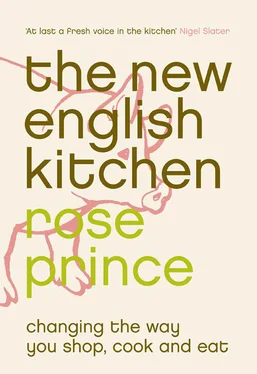At the time of writing, I buy flour in bulk and it costs me approximately 50 pence to make a loaf, plus negligible costs for yeast, oil and oven power. A loose calculation based on baking four good-quality loaves a week shows that I can save up to £312 a year on buying bread of comparable quality – money for treats.
I used to be hopeless at making scones. When I worked at the bakery, we threw away more scones than we sold because they were always dry, weighty and crumbly. Twenty years later I nibbled a sample scone from a stall at a farmers’ market. Light and chewy, without a hint of dryness, this was the scone we were never able to make in the bakery. The stall-holder, slightly taken aback by the passionate interrogation I inflicted on her, casually remarked, ‘Oh, it’s the flour.’ She bought her flour from Cann Mills, a local water mill in Dorset. She did not know why it was so good, it just was.
I wanted to know more, so I visited the mill. The miller, Michael Stoate, took up the story of good wheat flour, the type most commonly used for making bread, scones and cakes. The modern milling industry rolls the grain to remove the bran, taking out the wheatgerm and the flour’s natural oil as it does so. This also removes a vital source of vitamins, which means that they have to be added back to the flour artificially. The wheatgerm oil is very valuable to the pharmaceutical industry, which puts it into creams to go on the outside of our bodies – oh, the irony of it. What’s more, commercial bakers need not mention that it is missing from the flour. About 70 per cent of the bread bought in the UK is made from roller-milled white flour. That is a scandalous amount of missing wheatgerm from what most of us presume is a wholefood.
Stoneground flour, whether white or brown, still contains the wheatgerm – the white flour is simply sifted to remove the bran. Michael Stoate uses millstones to grind all his flour, including the white flour that was used in those scones, with their delightful texture. Traditionally milled stoneground flour can be bought direct from mills, and in some cases delivered to your home (see the Shopping Guide). Look also in specialist independent food shops, farm shops or farmers’ markets, and on the internet. Some supermarkets stock British flour from traditional mills, but do check the label carefully.
Store flour in a sealed bin to keep out pests, or buy it in smaller bulk bags of about 5 kilos that can be sealed between use.
Bread baked in tins or shaped into high rounds needs strong flour, made from ‘hard’ wheat species. These contain a greater amount of glutenin and gliadin, essential for the bread to rise well and form a nice, elastic crumb. In the past, hard wheat was grown mainly in North America for the British bread industry, but with selective breeding it has been adapted over the last few decades to grow well in British conditions. Do not confuse strong flour with hard durum wheat flour, or semolina, which is used specifically for pasta making.
Soft wheat flour, sold as plain flour, is suitable for cake and pastry making and can also be used for soda bread and scones.
While the gluten in wheat flour is vital for the standard bread recipe, a percentage of another type of cereal flour can be added for variety, such as rye, barley, buckwheat or oats. These cereals, however, contain little gluten, and yeast bread made with rye, barley or oat flour alone will be heavy, and does not keep well. Alternative types of flour, made from vegetables like chick peas or potato, are more useful in other forms of cookery. There are recipes using these flours ( here.
Fast-action, or easy-blend, yeast is now the most widely available type. It can be mixed straight into the flour, speeding up breadmaking by about half an hour. Conventional dried yeast, sold loose in tins, should be used in the same quantity but must be dissolved in warm water first. Compressed or fresh yeast is not always easy to find now. The best places to try are independent bakeries and some health-food shops. It should be dissolved in warm water or milk before adding it to the dry ingredients. If substituting fresh yeast for dried, you will need double the quantity stated in the recipe.
The breadmaking process is easier to understand once you know a little piece of molecular chemistry. Yeast gives dough its oomph, but it needs gluten to do so. Live yeast makes bubbles of carbon dioxide in the soft, elastic dough. The legend of the first yeast goes that a cook left a piece of dough near a vat of beer and some of the wild yeasts from the ale got into the dough. The cook noticed the bubbles in the bread – the rest is history.
When water comes into contact with flour, it swells the proteins in it. Kneading the dough by hand or machine allows these proteins to blend, changing the molecular structure and forming the all-important gluten.
You must choose if you want to add fat to your bread. Fat improves bread’s keeping qualities and gives it a denser texture. It can, however, prevent the dough becoming soft and elastic if it is rubbed into the flour before the water is added, because this delays the essential formation of gluten. Gluten is to dough what steel frames are to skyscraper construction. Its strength allows large spaces of air to form and hold within the dough. The best way to get bread going quickly is to add fat after the water. I do this by oiling the bowl that holds the dough as it rises, then mixing it in before the bread is shaped.
It is fine to leave fat out of bread; it simply results in a lighter dough with large bubbles. If you make small quantities of bread frequently, or rolls, there is no real need to add fat.
Two things kill yeast: too much salt, and heat. Don’t be too free with salt – follow the amount specified in recipes until you get to the stage where experience teaches you how much to add. And don’t leave the dough to rise anywhere too hot, such as on a radiator or beside a fire. In fact, bread doesn’t have to be left in a warm place to rise at all, and will even rise perfectly happily – though slowly – in the fridge. The important thing is that it should be in a draught-free place.
how to knead bread by hand
Take the dough, which will still be sticky, out of the bowl and place it on a floured work surface. Use both hands to pull and stretch the bread, folding it back on itself, pulling and stretching again, giving it a quarter turn each time. Persevere for several minutes – 15 is best. The process helps the gluten develop, making the dough silky, soft and elastic. Be robust when kneading – you can be as aggressive as you want, since it will speed up the process.
This recipe works well in a food mixer and can be used for the classic, rectangular tin loaf or for any other shape. Strong white flour, malted wheat, wholemeal or a mixture all work well.
Makes 2 small loaves
700g/1 1/ 2lb flour
2 x 7g sachets of fast-action (easy-blend) yeast
1 heaped teaspoon fine salt or 2 teaspoons soft sea salt crystals
1 heaped teaspoon unrefined sugar
425ml/14fl oz water, at blood temperature
1 tablespoon vegetable or olive oil (optional – see here)
Put the flour in a large bowl with the yeast, salt and sugar and stir until combined. Make a well in the centre and add the warm water, stirring all the time until the ingredients form a sticky dough. Continue to knead the bread – by hand (see above) for 15 minutes, or for 5 minutes on the slow setting of a food mixer fitted with a dough hook. If the dough is too sticky, add more flour; if it is too dry, work in a little water.
Читать дальше












